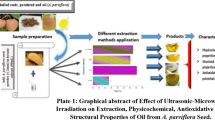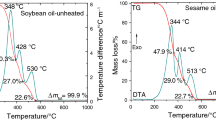Abstract
This research reports on the studied effect of the intensity of ultrasound (24 kHz) on the quality characteristics of olive oil, sesame oil, sunflower seed oil, and tallow olein. These characteristics (free acidity, peroxide value, conjugated dienes concentration, viscosity, iodine value, turbidity, color values, and melting behavior) were determined in oil samples before and after ultrasonic treatment. Changes in the oxidation parameters showed that the high-intensity ultrasound treatment accelerated the deterioration of oils. In most cases, extra-virgin sesame oil was most resistant to deterioration from sonicating treatments. The decreases in β-carotene content and Hunter values revealed that ultrasound might have good potential for bleaching oils at an appropriate intensity and frequency. The differential scanning calorimeter thermograms, viscosity, and turbidity results indicated that ultrasound probably accelerates the polymerization of the oils. The present study has confirmed that some changes in the physicochemical parameters or structures of oil components had occurred. These changes depended on the sources and initial conditions of the oils as well as the intensity of the applied ultrasound.
Similar content being viewed by others
References
Pingret D, Fabiano-Tixier AS, Le Bourvellec C, Renard CMGC, Chemat F (2012) Lab and pilot-scale ultrasound-assisted water extraction of polyphenols from apple pomace. J Food Eng 111:73–81
Chemat F, Huma Z, Kamran Khan M (2011) Applications of ultrasound in food technology: processing, preservation and extraction. Ultrason Sonochem 18:813–835
Knorr D, Zenker M, Heinz V, Lee DU (2004) Applications and potential of ultrasonics in food processing. Trends Food Sci Technol 15:261–266
Jafari SM, He Y, Bhandari B (2007) Production of sub-micron emulsions by ultrasound and microfluidization techniques. J Food Eng 82:478–488
Awad TS, Moharram HA, Shaltout OE, Asker D, Yousse MM (2012) Applications of ultrasound in analysis, processing and quality control of food: a review. Food Res Int 122:500–507
Riener J, Noci F, Cronin DA, Morgan DJ, Lyng G (2009) The effect of thermosonication of milk on selected physicochemical and microstructural properties of yoghurt gels during fermentation. Food Chem 114:905–911
Koohmaraie SM (1996) Biochemical factors regulating the toughening and tenderisation processes of meat. Meat Sci 43:S193–S201
Patrick M, Blindt R, Janssen J (2004) The effect of ultrasonic intensity on the crystal structure of palm oil. Ultrason Sonochem 11:251–255
McClements DJ (2005) Food emulsions: principles, practice, and techniques. CRC, Boca Raton, pp 87–90
Virot M, Tomao V, Le Bourvellec C, Renard CMCG, Chemat F (2010) Towards the industrial production of antioxidants from food processing by-products with ultrasound-assisted extraction. Ultrason Sonochem 17:1066–1074
Mason TJ, Chemat F, Vinatoru M (2011) The extraction of natural products using ultrasound or microwaves. Curr Org Chem 15:237–247
Margulis MA, Margulis IM (2003) Calorimetric method for measurement of acoustic power absorbed in a volume of a liquid. Ultrason Sonochem 10:343–345
AOCS (1996) Official methods and recommended practices of the AOCS, 4th edn. AOCS, Champaign
Eroshin VK, Satroutdinov AD, Dedyukhina EG, Christyakova TI (2000) Arachidonic acid production by Mortierella alpine with growth-coupled lipid synthesis. Process Biochem 35:1171–1175
Kyriakidis NB, Katsiloulis T (2000) Calculation of iodine value from measurements of fatty acid methyl esters of some oils: comparison with the relevant American Oil Chemists Society method. J Am Oil Chem Soc 77:1235–1238
Minguez MI, Rejano J, Gandul B, Higinio A, Garrido J (1991) Color-pigment correlation in virgin olive oil. J Am Oil Chem Soc 68:332–336
IUPAC (1992) Standard methods for the analysis of oils, fats and derivatives, 7th edn. Blackwell, Oxford
ASTM D7042-14 (2014) Standard test method for dynamic viscosity and density of liquids by stabinger viscometer (and the calculation of kinematic viscosity), ASTM International, West Conshohocken, PA
Tana CP, Che Mana YB, Selamatb J, Yusoffc MSA (2002) Analytical, nutritional and clinical methods section comparative studies of oxidative stability of edible oils by differential scanning calorimetry and oxidative stability index methods. Food Chem 76:385–389
Sivakumar M, Tang SY, Tan KW (2014) Cavitation technology—a greener processing technique for the generation of pharmaceutical nanoemulsions. Ultrason Sonochem 21:2069–2083
Pingret D, Durand G, Fabiano-Tixier AS, Rockenbauer A, Ginies C, Chemat F (2012) Degradation of edible oil during food processing by ultrasound: electron paramagnetic resonance, physicochemical, and sensory appreciation. J Agric Food Chem 60:7761–7768
Huang Q, Li L, Fu X (2007) Ultrasound effect on the structure and chemical reactivity of cornstarch granules. Starch 59:371–378
Diamante LM, Lan T (2014) Absolute viscosities of vegetable oils at different temperatures and shear rate range of 64.5 to 4835 s−1. J Food Process 25:261–267
Santos JCO, Santos IMG, Souza AG (2005) Effect of heating and cooling on rheological parameters of edible vegetable oils. J Food Eng 67:401–405
Chemat F, Grondin I, Costes P, Moutoussamy L, Shum Cheong Sing A, Smadja J (2004) High power ultrasound effects on lipid oxidation of refined sunflower oil. Ultrason Sonochem 11:281–285
Pingret D, Fabiano-Tixier AS, Chemat F (2013) Degradation during application of ultrasound in food processing: a review. Food Control 31:593–606
Adekunte AO, Tiwari BK, Cullen PJ, Scannell AGM, O’Donnell CP (2010) Effect of sonication on colour, ascorbic acid and yeast inactivation in tomato juice. Food Chem 122:500–507
Bermúdez-Aguirre D, Barbosa-Cánovas GV (2012) Inactivation of Saccharomyces cerevisiae in pineapple, grape and cranberry juices under pulsed and continuous thermo-sonication treatments. J Food Eng 108:383–392
Vercet A, Burgos J, López-Buesa P (2001) Manothermosonication of foods and food-resembling systems: effect on nutrient content and nonenzymatic browning. J Agric Food Chem 49:483–489
Besbes S, Blecker C, Deroanne C, Lognay G, Drira NE, Attia H (2005) Heating effects on some quality characteristics of date seed oil. Food Chem 97:469–476
Acknowledgments
The authors are grateful to Dr. Maryam Mizani for her useful suggestions and discussions.
Author information
Authors and Affiliations
Corresponding author
About this article
Cite this article
Hosseini, S., Gharachorloo, M., Tarzi, B.G. et al. Effects of Ultrasound Amplitude on the Physicochemical Properties of Some Edible Oils. J Am Oil Chem Soc 92, 1717–1724 (2015). https://doi.org/10.1007/s11746-015-2733-1
Received:
Revised:
Accepted:
Published:
Issue Date:
DOI: https://doi.org/10.1007/s11746-015-2733-1




